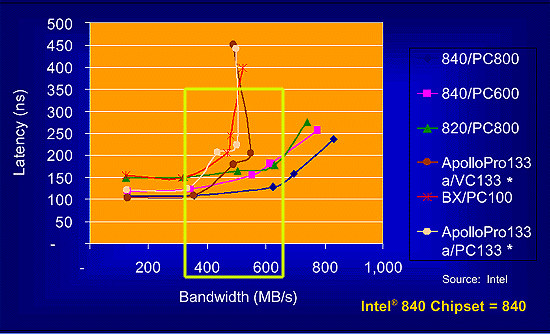What are we getting at?
Today's applications and games do not require 1.6 – 3.2GB/s of memory bandwidth. If they did, our PC133 SDRAM would be the limiting factor in every single benchmark we ran. Instead, we are still at a relatively low level of bandwidth utilization, illustrated by the lower part of the graph above. And as you can clearly see, as Intel themselves have illustrated, the i820 platform with PC800 RDRAM does have a higher latency than the VIA Apollo Pro 133A with PC133 SDRAM.
Intel's chart also places the BX chipset with PC100 SDRAM at an almost identical level in terms of latency as the i820 chipset with PC800 RDRAM, and the BX line even drops below the 820 line in terms of latency, indicating that Intel even admits that the BX chipset using older PC100 SDRAM is capable of outperforming the i820 chipset with its more expensive RDRAM.

It can also be assumed that if one overclocks the BX chipset to the 133MHz FSB here, the chipset would easily outperform the 820 platform, and since we know that the BX chipset has a higher performing memory controller than the Apollo Pro 133A we can safely predict that the performance of the BX chipset using the 133MHz FSB/memory bus would be higher than that of the Apollo Pro 133A at 133MHz, indicating an even lower latency. So while the line for BX/PC133 is not present on the above chart (for obvious reasons, Intel doesn't exactly condone overclocking), it is safe to assume that it would start out below the Apollo Pro 133A/PC133 line which is very close to the bottom of the graph, indicating a very low latency at current bandwidth usage patterns.
So how can Rambus say that RDRAM actually has a lower latency than SDRAM? Look further on in the graph.

As the bandwidth usage increases, the latency for PC100 and PC133 SDRAM on the various SDRAM platforms increases dramatically. In high bandwidth situations, the latency of RDRAM is actually lower than that of SDRAM because SDRAM is approaching its memory bandwidth limits while RDRAM still has quite a ways to go. But remember that we aren't constantly running an application or performing a task that requires such a large amount of memory bandwidth. Because of that, we don't see PC100/PC133 limiting our performance since at the lower bandwidth utilization points, the latency of SDRAM is actually lower than that of RDRAM.










0 Comments
View All Comments